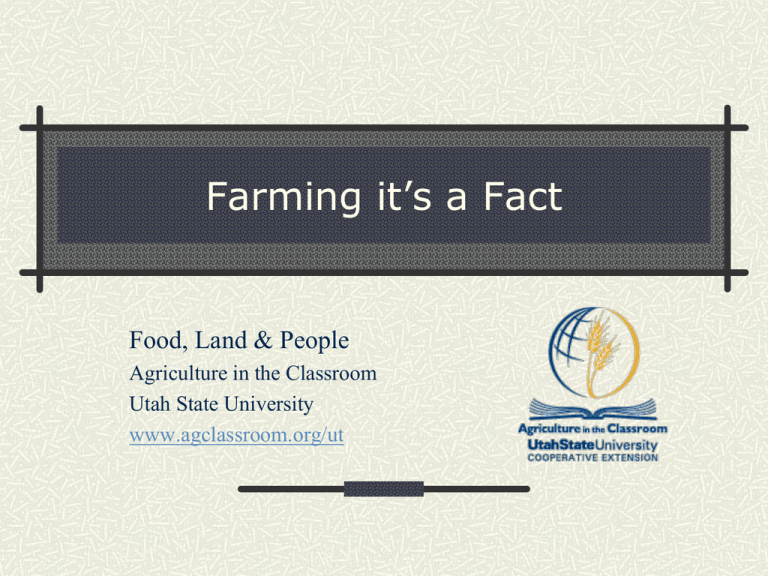Food for Thought… - Learnin' To Grow in Utah
advertisement

Farming it’s a Fact Food, Land & People Agriculture in the Classroom Utah State University www.agclassroom.org/ut What is Agriculture? Agriculture: the science or practice of farming, including the use of soil for the growing of crops and the raising of animals to provide food, wool, and other products. An Acre is About the Size of a Football Field What Does One Acre of Land Produce? 821 pounds of Cotton 2,784 pounds of Wheat 11,500 pounds of Sweet Corn 39,500 pounds of Potatoes 31,000 pounds of Oranges 35,600 pounds of Lettuce 50,000 pounds of Strawberries How Are You Connected to agriculture? Personal Care Products Construction Shampoo, soap, cosmetics, lotions, fingernail polish, toothpaste Lumber, paints, brushes, tar paper, drywall, tool handles, particle board Manufacturing Health Care Pharmaceuticals, surgical sutures, ointments, latex gloves, x-ray film Adhesives, lubricants, solvents, detergents, polymers Entertainment Film, strings for musical instruments Education Crayons, text books, chalk, desks, pencils, paper Printing Paper, ink, film Sports Uniforms, baseball bats, leather equipment and balls, shoes Transportation Biofuels including ethanol and biodiesel, lubricants, antifreeze, tires, upholstery, packing materials What’s on America’s Dinner Table? Flour & Cereal Products Fresh Fruits 173.3 pounds 127.5 pounds Milk 21 gallons Eggs 246 eggs Red Meats 111.7 pounds Fats & Oils 80.3 pounds Fresh Vegetables 184.8 pounds Cheese Rice Poultry and meat 21.2 pounds 80.0 pounds 32.8 pounds Are Farmers Reducing Cropland Erosion? 4.0 3.6 3.1 2.8 2.7 Tons of Soil Lost Per Acre 1982 1987 1992 1997 2002 2.6 Today Number of people fed annually by one farmer 19 27 46 73 115 129 139 143 What is a billion? If you had 1 million dollars and had to spend $1,000 dollars every day, your money would run out in 1000 days. If you had 1 billion dollars and had to spend $1,000 every day, your money would run out for 2,740 years. Who Pays the Least for Food? Of the 10 percent of disposable income Americans spend on food each year, 51 percent is for food eaten at home and 49 percent is for food eaten away from home. State that produces the most food and has the highest farm-gate sales Rank State $ in Thousands 1 California $36,574,850 2 Texas $19,074,827 3 Iowa $19,036,853 4 Nebraska $14,555,820 5 Minnesota $12,538,429 6 Kansas $11,729,328 7 Illinois $11,678,609 8 Wisconsin $8,858,242 9 North Carolina $8,691,099 10 Indiana $7,775,742 USDA – ERS: 2009 What is the U.S. Share of World Production? Soybeans 35% Beef and Veal 21% Cotton 12% Corn 41% Eggs 8% Milk 17% Wheat 9% How Many Farms and Farmers? How Many Farmers? 3,337,450 farm operators 306,209 women 55,570 farmers of Spanish, Hispanic, or Latino origin 30,599 African American 79,703American Indian Family Farms & Family Farm Production What is USDA’s Budget? Food Assistance and Nutrition Programs 74% Ag Programs 10% Conservation and Forestry 8% Other 8% The other consists of: food safety, rural development and research, research and marketing/regulatory programs. Also make a footnote that says that Food Assistance and Nutrition Programs include: SNAP (formerly known as food stamps), Women, Infants, and Children or WIC, and school lunch/breakfast programs. In 2012: $144.2 billion Where Does Your Food Dollar Go? 16¢ FARM Farm Cost, breakdown of 16 cents: •15.8% purchased feed •15/1 % fertilizer, seed, crop-protecting chemicals •10.3% capital upkeep and replacement •10.0 % farm labor •9.4% interest and property taxes •7.1% fuel, electricity •6.9% purchased livestock •5.0% farm services •5.2% repairs, maintenance •3.6% rent •11.6% miscellaneous 84¢ OFF-FARM Off-Farm Costs: • Marketing expenses associated with processing • Wholesaling • Distributing • Retailing of food products Who Imports U.S. Farm Products? What Do We Trade on the World Market? Top Exports (billions) U.S. Ag Exports = $115.8 billion What Do We Trade on the World Market? Top Imports (billions) U.S. Ag Imports = $81.9 billion What is Agriculture? Farms Food Fabric Forestry Flowers The 5 F’s of Agriculture: Farms: Things we grow and raise. Like dairy cows. What a Dairy Cow consume and produces in a day? 3.3 pounds of butter OR 35 gallons of water 35 pounds of hay or silage 20 pounds of grain and concentrated feed 8.1 gallons of milk OR VALUE of a cow’s daily production = $11.45 COST Feed = $4.60 Supplies = $2.90 Bldgs./overhead = $3.75 ______________________ Daily Costs = $11.25 RETURN on Labor = $0.20 7.0 pounds of cheese Fish farming: Aquaculture Top Five Aquaculture States in Sales Mississippi Arkansas Alabama Louisiana Florida U.S. aquaculture products Food Fish Mollusks Miscellaneous Fish Crustaceans Ornamental Fish Bait Fish Sport Fish Food: What’s in the Grocery Store and Restaurants: Pizza for example Your favorite pizza originates on America’s farms and ranches Top-Producing States: Mozzarella Cheese (Dairy Products) Spinach California, Arizona California, Wisconsin, Pennsylvania Mushrooms Tomato Sauce (Fresh Tomatoes) Pennsylvania, California California, Florida, Virginia Onions Pizza Dough (Winter Wheat) Georgia, California, Texas Kansas, Oklahoma, South Dakota Green Peppers Sausage (From Hogs) California, Florida Iowa, North Carolina, Minnesota Pineapple Hawaii Fabric or Fiber: Agriculture provides natural fibers to make cloth Vegetable Fibers Seed fiber (cotton, kapok, milkweed) Stalk/Stem (bamboo, flax/linen, ramie, hemp, jute, rattan) Animal Fibers Wool (sheep) Mohair (angora goat) Cashmere (goats) Angora (rabbit) Alpaca (alpaca, resembles small llama) Feathers (chickens) Fur (mink, fox) Leather (pigs, cattle, sheep, etc Silk (caterpillars) Catgut (animal intestines, all kinds of animals except cats) Forestry or Silviculture? Who Owns America’s Forests 750 million acres of the U.S. is covered by trees (about 1/3 of the U.S.) The National Forest Service manages 193 million acres of forested land. 145 million acres or 75 percent is set aside for non-commercial use: Wildlife habitat Recreational activities Forest products industry 11 percent Federal, state and local governments 37 percent Private citizens 52 percent Flowers: Horticulture: Top Producing States. Typical Greenhouse Crops Floral, foliage and vegetable plants including tomatoes Transplant seedlings and bulbs Aquatic plants Mushrooms, herbs and seeds Typical Nursery Crops Cut and live Christmas trees Ornamental plants and trees with woody stems Fruit and nut plants for outdoor/ landscape use Ornamental vines Turfgrass sod and other groundcovers Fuels from Agriculture Renewable bio-based fuels Biodiesel Ethanol








